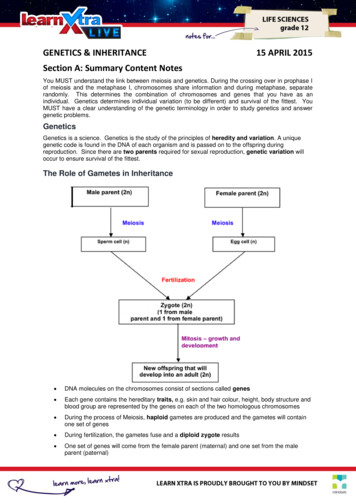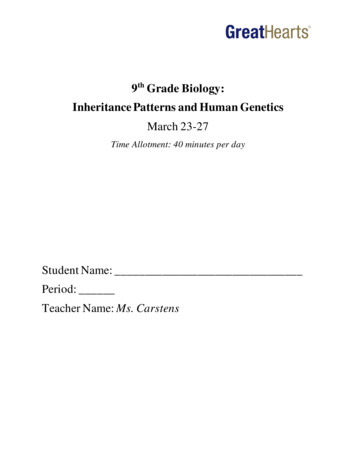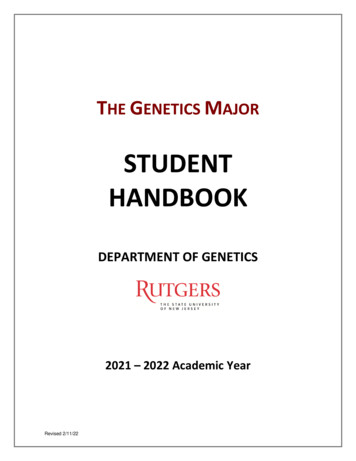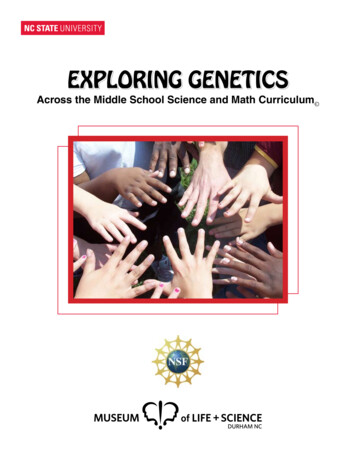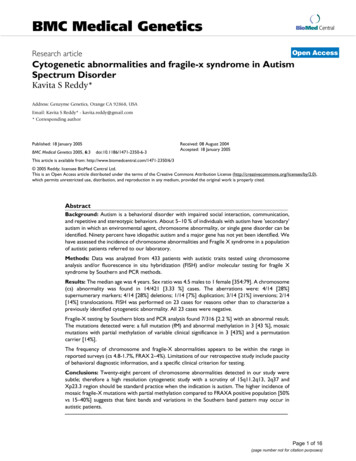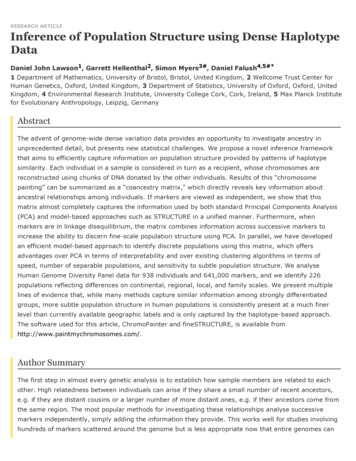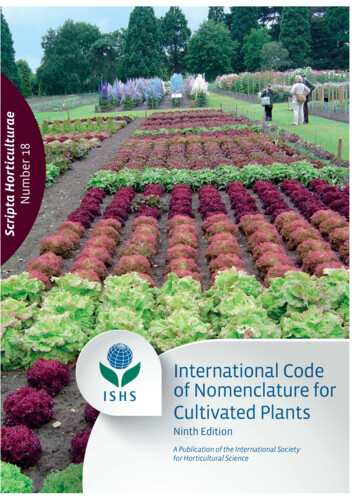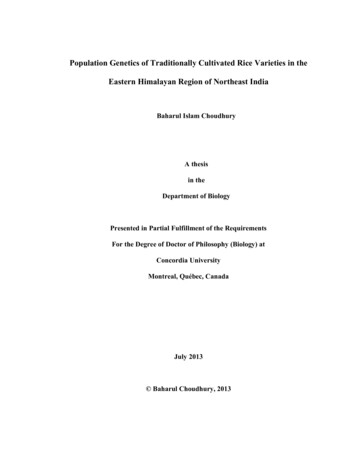
Transcription
Population Genetics of Traditionally Cultivated Rice Varieties in theEastern Himalayan Region of Northeast IndiaBaharul Islam ChoudhuryA thesisin theDepartment of BiologyPresented in Partial Fulfillment of the RequirementsFor the Degree of Doctor of Philosophy (Biology) atConcordia UniversityMontreal, Québec, CanadaJuly 2013 Baharul Choudhury, 2013
CONCORDIA UNIVERSITYSchool of Graduate StudiesThis is to certify that the thesis preparedBy:Baharul ChoudhuryEntitled:Population Genetics of Traditionally Cultivated Rice Varieties in theEastern Himalayan Region of Northeast Indiaand submitted in partial fulfillment of the requirements for the degree ofDoctor of Philosophy (Biology)complies with the regulations of the University and meets the accepted standards withrespect to originality and quality.Signed by the final examining committee:Dr. Peter DarlingtonChairDr. R. Uma ShaankerExternal ExaminerDr. David F. GreeneExternal to ProgramDr. Dan McLaughlinExaminerDr. William ZergesExaminerDr. Selvadurai DayanandanThesis SupervisorApproved byDr. Selvadurai DayanandanChair of Department or Graduate Program DirectorDr. Brian LewisDean of Faculty
ABSTRACTPopulation Genetics of Traditionally Cultivated Rice Varieties in the EasternHimalayan Region of Northeast IndiaBaharul Choudhury, Ph.D.Concordia University, 2013The Eastern Himalayan region of northeast (NE) India covers a geographical areaof over 255,000 sq. km. and consists of Arunachal Pradesh, Assam, Manipur, Meghalaya,Mizoram, Nagaland and Tripura states (Figure 1.1). This region encompasses wide rangeof eco-geographical conditions, ranging from lowland flood plains of Brhamaputra andBarak River to mountains as high as 4000 m above sea level in the West Kameng andTawang region of Arunachal Pradesh. Rice (Oryza sativa) is the staple food of the localinhabitants in NE India. Traditional farmers of the region cultivate a large number ofindigenous rice varieties under diverse topographic and agroclimatic conditions anddifferent growing seasons. However, rice genetic resources in NE India are being rapidlylost due to changes in the land use and agricultural practices that favor agronomicallyimproved varieties. A detailed understanding of the genetic structure and diversity of ricevarieties in NE India is crucial for developing conservation and management strategies ofrice genetic resources and use of the rice gene pool in the region for breeding and geneticimprovement programs.In this study, genetic structure and diversity of rice varieties representing severalecotypes collected from various regions of NE India were investigated using moleculartools. Chapter 1 covers a study focused on the genetic structure and diversity of 24indigenous varieties representing Sali (12), Jum (4), Boro (3), and glutinous (5) types andiii
five agronomically improved varieties. The results revealed that the genetic diversityamong indigenous rice varieties was higher than that of the agronomically improvedvarieties. The Sali and Jum types showed significantly higher levels of genetic diversityas compared to agronomically improved types. Two major genetically distinct clusterswere detected in this study, which corresponded to two subspecies of O. sativa, namelyindica and japonica.In Chapter 2, the results of a study on characterization of rice ecotypes intojaponica or indica subspecies using insertion-deletion (indel) markers are presented. Theindel markers were designed based on the genome-wide DNA polymorphism database oftypical indica cv 93-11 and japonica cv Nipponbare. The result showed that thetraditional method of indica and japonica rice classification based on cultivation type,morphological traits, physiological and biochemical characteristics is incongruent withthe indel marker based classification. Majority of the upland (Jum) and glutinous seededvarieties, which were traditionally classified as japonica clustered with indica types.Similarly, a few lowland varieties, which were traditionally classified as indica clusteredwith japonica types.Chapter 3 covers the nucleotide polymorphism and patterns of nucleotidediversity at two trait specific genes, Wx and OsC1. The Wx gene is associated withamylose content, which determines the glutinous nature of rice grains while the OsC1gene is associated with the apiculus coloration. The polymorphism in the Wx gene amongglutinous and nonglutinous grain types, and the nucleotide diversity in the OsC1 geneamong colored and colorless apiculus rice varieties were investigated. The resultsrevealed that trait specific nucleotide polymorphisms that were identified in previousiv
studies did not necessarily correspond to the specific phenotypes in the indigenous ricevarieties of NE India. The glutinous type varieties showed higher levels of nucleotidediversity as compared to the nonglutinous types at the Wx locus. The neutrality analysisdid not reveal signature of selection among the glutinous and nonglutinous ricephenotypes at the Wx gene. On the other hand, the OsC1 gene revealed low level ofselection among the colorless apiculus varieties as evident by lower nucleotide diversityin colorless types as compared to the colored apiculus varieties.v
ACKNOWLEDGEMENTSI express my sincere appreciation to my supervisor Dr. Selvadurai Dayanandan forhis valuable suggestions and guidance throughout the period of this project. Hiscontinuous effort, encouragement, endless support and wisdom greatly helped me inlearning and understanding my research. I am indebted to him far beyond words.I also express my sincere gratitude to my committee members and examiners Dr.Dan McLaughlin and Dr. William Zerges for their valuable comments that improved mythesis significantly. I gratefully acknowledge the guidance and support received from Dr.M.L. Khan (Department of Botany, Dr. Harisingh Gour Central University, Sagar, India)throughout the course of the study. His encouragement always helped me in movingforward with my research.I would like to thank Concordia University and Natural Sciences and EngineeringResearch Council of Canada for financial support. I am especially indebted to the LeFond Québécois de la Researche sur la Nature et les Technologies, the Faculty of Artsand Science and the Biology Department of Concordia University and the GraduateAwards Committee for granting their prestigious awards to me. I acknowledge theInternational Rice Research Institute, Philippine for providing samples for this study.I give thanks to my lab colleagues, past and present members and especially Atiqurat the Forest and Evolutionary Genomics Lab. Assistance received from Sabrina andKristiana are gratefully acknowledged.I extend my special acknowledgement to my parents for support and care thatgreatly helped me to achieve this goal. Finally, words fail to express the appreciation andlove to my wife Sabnam for her devotion, encouragement and endless support during thewhole period. She is and will be my constant source of inspiration and motivation.vi
TABLE OF CONTENTSLIST OF FIGURES .ixLIST OF TABLES .xiGENERAL INTRODUCTION .1CHAPTER 1: Genetic Structure and Diversity of Indigenous Rice (Oryza sativa)Varieties in the Eastern Himalayan Region of Northeast India 7INTRODUCTION .9MATERIALS AND METHODS 14RESULTS .20DISCUSSION .35CHAPTER 2: Genetic Characterization of Indigenous Rice Varieties in the EasternHimalayan Region of Northeast India 40INTRODUCTION .41MATERIALS AND METHODS 43RESULTS .50DISCUSSION .56vii
CHAPTER 3: Patterns of Nucleotide Diversity and Phenotypes of TwoDomestication-Related Genes (OsC1 and Wx) in Indigenous Rice Varieties inNortheast India .59INTRODUCTION .60MATERIALS AND METHODS 64RESULTS 70DISCUSSION .80GENERAL CONCLUSION .86REFERENCES . 88APPENDICES . 106APPENDIX 1:ALIGNED NUCLEOTIDE SEQUENCES OF THE Wx GENE . 106APPENDIX 2:ALIGNED NUCLEOTIDE SEQUENCES OF THE OsC1 GENE . 135viii
LIST OF FIGURESCHAPTER 1Figure 1.1 10Map of Northeast India showing sampling sites of traditionally cultivated indigenous ricevarietiesFigure 1.2 12Variation in grain morphology of a few representative varieties included in this studyFigure 1.3 18Graph showing number of genotyped individuals and corresponding numbers of alleles atthe locus RM302Figure 1.4 27UPGMA tree based on chord genetic distance (Cavalli-Sforza and Edwards 1967)showing genetic relationships among 29 rice varieties in Northeast IndiaFigure 1.5 29Sub-groups of rice varieties within group-I (indica) and group-II (japonica) based oncultivation type, grain characteristics and geographic originFigure 1.6 30Principal component analysis of indigenous and agronomically improved rice varietiesbased on 7 SSR loci. Different varieties grouped together corresponding to twosubspecies (indica and japonica)Figure 1.7 The relationship between ΔK and K showing the highest peak at K 231Figure 1.8 32Population structure of traditionally cultivated indigenous and agronomically improvedrice varieties in the Eastern Himalayan regionFigure 1.9 34STRUCTURE output (a) including agronomically improved varieties and (b) withoutagronomically improved varieties. Note that three varieties (Kawanglawang, LocalBasmati and Bashful; 3, 6, and 18 marked with asterisk) interchanged between group-I(indica) and group-II (japonica) groups in (a) while all varieties of group-I (indica) andgroup-II (japonica) found in UPGMA and PCA analysis clustered together in (b)ix
CHAPTER 2Figure 2.1 48Polyacrylamide gel electrophoresis image of 7 rice varieties genotyped with 3 indelmarkers (R6M30, R7M7, R8M33) showing indica and japonica specific bandsFigure 2.2 52The scatter plot of indigenous rice varieties based on principal component analysis (PCA)showing significant genetic differentiation into indica, japonica and intermediate ricegenotypes in NE IndiaFigure 2.3 54Results of STRUCTURE analysis showing 2 major groups of rice varieties correspondingto indica (red colored segment) and japonica (green colored segment) types. Theintermediate varieties with admixed ancestry are indicated in red and green color barsFigure 2.4 UPGMA tree based on genetic distance (Nei 1972) among rice varieties55CHAPTER 3Figure 3.1 67The locations of the coding and non-coding regions of Wx (A) and OsC1 (B) genes.Arrows at the bottom indicate primers used for PCR amplificationFigure 3.2 73Nei’s Nucleotide diversity (π) patterns along Wx gene (promoter region; exon; intron) insliding window among glutinous and nonglutinous grain typesFigure 3.3 73Tajima’s D statistics in sliding window analysis for the Wx locus among glutinous andnonglutinous rice varietiesFigure 3.4 78Nei’s Nucleotide diversity (π) patterns along OsC1 gene in sliding window among redand colorless colored apiculus in riceFigure 3.5 78Tajima’s D statistics in sliding window analysis for the OsC1 locus among the coloredand colorless apiculus rice grainsx
LIST OF TABLESCHAPTER 1Table 1.1 Cultivation type, location and genetic diversity values of traditionally cultivatedindigenous and agronomically improved rice varieties including the wild rice (O.rufipogon) in NE India15Table 1.2 17Details of SSR loci used in the present study and their genetic diversity parametersTable 1.3 Pairwise FST values among different rice varieties of eastern Himalayan region inNortheast India and O. rufipogon22Table 1.4 25Population structure and F-statistics of different types of indigenous and agronomicallyimproved rice varieties in NE IndiaTable 1.5 Analysis of molecular variance (AMOVA) based on 7 SSR loci of traditional andagronomically improved rice varieties in Northeast India26CHAPTER 2Table 2.1 44List of rice varieties collected from NE India, their location, cultivation type, (Fi)frequency of indica allele (maximum, minimum and average) and classification usingindel marker systemTable 2.2 List of indel markers, their map positions and annotation in the rice genome46CHAPTER 3Table 3.1 65Rice variety names, phenotype, and functional mutations at the Wx and OsC1 generegionsTable 3.2 List of genes surveyed and primer sequences used in the study66Table 3.3 Lengths of aligned gene regions (bp) and site categories71xi
Table 3.4 Levels of nucleotide variation at the two studied gene regions74Table 3.5 79McDonald-Kreitman test for the Wx and OsC1 genes between different types and O.rufipogonxii
General IntroductionAsian cultivated rice (Oryza sativa L.) is one of the most important crops in theworld and a major food source for over half of the global human population. Riceconsumption data between 1961 and 2005 showed that about 20% of the daily calorieneeds of the world population are met by rice (World Rice Statistics 2010). Rice is alsothe basis of food security in many developing countries and closely associated withcultural traditions and customs in local regions (Lu and Snow 2005). It is grownworldwide in diverse agroclimatic, edaphic and topographic conditions.O. sativa is considered to have been domesticated from its wild ancestor, O.rufipogon by the Asian Neolithic farmers approximately 10,000 years ago (Normile1997). Since its domestication, cultivated rice may have undergone significant geneticdifferentiation resulting in the evolution of several ecotypes, subgroups and varieties invarious rice growing regions. A major differentiation of O. sativa resulted in two partiallyisolated gene pools referred to indica and japonica. These two major groups of varieties,also often referred to as subspecies, are distinguished on the basis of a number ofmorphological, physiological, biochemical and molecular traits (Oka 1988; Vaughan etal. 2008; Lu et al. 2009). A recent genome-wide study revealed that indica wasdomesticated in South and South East Asia while japonica was domesticated in SouthernChina (Huang et al. 2012). Further diversification of the O. sativa complex into at leastfive distinct groups such as indica, aus, aromatic, temperate japonica, and tropicaljaponica have also been reported (Garris et al. 2005). The combined effects of naturaland human induced selection may have played a significant role in genetic differentiationleading to morphological discontinuity, genetic incompatibility and eventually the1
evolution of different subspecies and diverse varieties (Wang et al. 1998). Culturalpractices and consumer quality preferences may also have played a significant role inshaping the diversification of rice varieties.Plant domestication and trait diversityDomestication refers to a process of selecting wild varieties of organisms with traitspreferred by human needs (Darwin 1859). In other words, plant domestication is aprocess of genetic selection of wild species to meet human needs (Doebley et al., 2006).The most important domestication related traits identified so far in rice with significantmorphological and physiological modifications are reduction in grain shattering (Konishiet al. 2006; Li et al. 2006a), changes in grain coloration (Sweeney et al. 2006), grain sizeand shape (Yamanaka et al. 2004), grain fragrance and flavor (Bradbury et al. 2005),grain number (Ashikari et al. 2005), grain weight (Song et al. 2007) and grain stickiness(Yamanaka et al. 2004). Synchronization of seed maturation, reduction in tiller number,increase in tiller erectness, increase in panicle length and branches, and reduction in awnlength are also important traits related to domestication (Bres-Patry et al. 2001; Thomsonet al. 2003; Li et al. 2006b; Sang and Ge 2007a).During the domestication of crop plants, many traits of ecological and economicimportance have been selected while others may have been lost. This is because earlyfarmers selected seeds only from what they considered as the ‘best’ plants, which formedthe next generation and much of the genetic diversity in the progenitor was left behind(Doebley et al. 2006). Estimates suggest that cultivated rice maintained less than 25% ofthe genetic diversity found in its wild progenitors, depicting a severe genetic erosion2
during domestication (Zhu et al. 2007). Sakai and Itoh (2010) estimated loss of at leastone thousand genes in cultivated O. sativa that are still preserved in the genomes of wildrelatives. Out of the two major subspecies of rice, O. sativa ssp. indica is considered tomaintain twice as much genetic diversity than O. sativa ssp. japonica, suggesting that theformer had a larger founding population and/or may have been subject to a less severebottleneck during domestication (Sang and Ge 2007a).The history of rice domesticationThe history of rice domestication is complex and has been reviewed by manyauthors (e.g. Vaughan et al. 2005; Doebley et al. 2006; Kovach et al. 2007; Sang and Ge2007b; Izawa 2008, Fuller et al. 2010; McCouch et al. 2012). The recentarchaeobotanical evidence suggests that the process of rice domestication occurred in theLower Yangtze region of Zhejiang, China (Fuller et al. 2009). Phylogeographic studiessuggest that O. sativa ssp. indica was domesticated from wild rice progenitors in a regionSouth of the Himalayan mountain range, likely Eastern India, Myanmar and Thailand,whereas O. sativa ssp. japonica was domesticated in and around Southern China (Khush1997; Londo et al. 2006). This was further supported by a recent genome-wide study(Huang et al. 2012). In general, the geographic region of rice domestication is consideredto have started from NE India extending eastward to Nepal, Myanmar and the Southwestcorner of China in Yunnan Province (Chang 1976).3
Rice diversity in Northeast IndiaThe diversity of traditional rice varieties in the Indian subcontinent is very highsuggesting that this region may have played an important role in the domesticationprocess of the crop. For instance, many studies show that the Jeypore tract of Orissa inEastern India could be considered as a region that played a significant role indomestication of cultivated rice in India (Sampath and Govindaswami 1958; Oka 1964;Govindaswami et al. 1966; Akihama and Toshimitsu 1972). Similarly, the diversity ofboth indigenous varieties and wild relatives of rice is very high in the Eastern Himalayanregion of NE India. The NE Indian region consists of seven states namely ArunachalPradesh, Assam, Manipur, Meghalaya, Mizoram, Nagaland and Tripura (Figure 1.1) andcovers an area of more than 255,000 sq. km. It is estimated that about 10,000 indigenousrice cultivars of agronomical, ecological and cultural importance are still preserved in NEIndia (Hore 2005). Such vast rice gene pools may possess many traits of agronomic andecological significance.Rice varieties cultivated at higher elevation areas (2,500-3,000 m asl) in the state ofArunachal Pradesh possess morphological features attributable to O. sativa ssp. japonicasuch as a globose grain, narrow, dark green and drooping flag leaves and a thin culm(Gupta et al. 1995). About 40% of the ‘Jum’ (slash and burn agriculture) cultivated ricevarieties in Nagaland state show morphological features intermediate between japonicaand indica. Many rice varieties cultivated in Nagaland also show wide variation in grainsize and shape, awn characters, glume and kernel color. Soft and sticky rice varieties areabundant in Meghalaya and at least 20 dominant landraces are still cultivated in GaroHills district of the state. Lowland and deep water rice cultivation is common in Assam4
with numerous scented, glutinous and colored grain varieties. The state of Mizoram isrich in aromatic and sticky rice as well as a few drought and cold tolerant varieties.Jum cultivation is the main land use practice in the hill region of NE India(Ramakrishnan 2006). Rice varieties with special adaptations to upland areas are widelycultivated in such agricultural systems with no surface water accumulation. Jum ricevarieties cultivated in the upland areas of South East Asia are considered as japonicatype. On the other hand, farmers residing at low-lying flood plains of Assam andadjoining states cultivate different varieties of rice in different seasons. The two majorgrowing seasons of this region are cold and dry seasons (Boro type during Nov to May)and hot, humid and rainy seasons (Sali type during Jun-Dec). The Sali type of varietiesgrown during the rainy season is the major crop having higher yield, better grain qualityand superior agronomic traits. Traditional classification system categorized Sali type astypical indica type. These are widely cultivated throughout tropical Asia.The other varieties, commonly known as Boro are traditionally cultivated duringthe winter season (January to April) in low-lying areas where sufficient water is retainedduring the cold and dry spells of the year. Boro rice may have some degree of coldtolerance because of their adaptation for winter conditions. In addition to the cultivatedrice, natural populations of many wild rice species such as Oryza rufipogon, O.granulata, O. officinalis, O. nivara, O. meyeriana, Hygrorhiza aristata, Leersia hexandraand Zizenia latifolia are also found in the northeastern region of India (Hore 2005).Introduction of agronomically improved varieties, changes in agricultural practicesand habitat loss are posing serious threat to the rice gene pool of the region. Therefore,strategic conservation of such genetic resources is urgently needed. A detailed knowledge5
of the levels of genetic diversity and genetic differentiation among different rice varietiesin the Eastern Himalayan region is crucial for planning conservation, management andsustainable use of rice genetic resources in the region.With this background, my study focused on investigating the population geneticstructure of traditionally cultivated indigenous rice varieties in the Eastern Himalayanregion of NE India. In Chapter 1, I report the results of a study focused on within andamong variety genetic diversity and distribution of genetic diversity among differentecotypes and agronomically improved rice varieties from NE India using SSR markers.In Chapter 2, indica and japonica-specific insertion or deletion (indel) markers were usedto identify the nature of genetic differentiation among different rice varieties or ecotypesin the region. In Chapter 3, I present the results of the analyses of DNA sequencevariation of selected trait-specific genes in different phenotypic groups highlighting thenature of polymorphism and signatures of selection.6
Chapter 1: Genetic Structure and Diversity of Indigenous Rice (Oryza sativa)Varieties in the Eastern Himalayan Region of Northeast IndiaAbstract: The Eastern Himalayan region of NE India is home to a large number ofindigenous rice varieties, which may serve as a valuable genetic resource for future cropimprovement to meet the ever-increasing demand for food production. However, thesevarieties are rapidly being lost due to changes in land-use and agricultural practices,which favor agronomically improved varieties. A detailed understanding of the geneticstructure and diversity of indigenous rice varieties is crucial for efficient utilization ofrice genetic resources and for developing suitable conservation strategies. To explore thegenetic structure and diversity of rice varieties in NE India, I genotyped 300 individualsof 24 indigenous rice varieties representing Sali, Boro, Jum and glutinous types, 5agronomically improved varieties, and one wild rice species (O. rufipogon) using sevenSSR markers. A total of 85 alleles and a very high level of gene diversity (0.776) weredetected among the indigenous rice varieties of the region. Considerable level of geneticvariation was found within indigenous varieties whereas improved varieties weremonoporphic across all loci. The comparison of genetic diversity among different typesof rice revealed that Sali type possessed the highest gene diversity (0.747) followed byJum (0.627), glutinous (0.602) and Boro (0.596) types of indigenous rice varieties, whilethe lowest diversity was detected in agronomically improved varieties (0.459). TheAMOVA results showed that 66% of the variation was distributed among varietiesindicating a very high level of genetic differentiation in rice varieties in the region. Twomajor genetically defined clusters corresponding to indica and japonica groups were7
detected in rice varieties of the region. Overall, traditionally cultivated indigenous ricevarieties in NE India showed high levels of genetic diversity comparable to levels ofgenetic diversity reported from wild rice populations in various parts of the world. Theefforts for conservation of rice germplasm in NE India should consider saving ricevarieties representing different types with specific emphasis given to Sali and Jum types.The protection against the loss of vast genetic diversity found in indigenous rice varietiesin NE India is crucial for maintaining future food security in the changing world.Keywords: Conservation; Eastern Himalaya; Genetic diversity; Genetic structure;Indigenous rice varieties; NE India.8
IntroductionThe Asian cultivated rice (Oryza sativa L.) is one of the most important crops and amajor food source for more than half of the global human population. Phylogeographicaland archeological evidence suggest that rice was domesticated over 10000 years ago fromits wild ancestor O. rufipogon in the region south of the Himalayan mountain range,likely in the present day Eastern and NE India, extending Eastward to Nepal, Myanmarand Thailand to Southern China (Chang 1976; Khush 1997; Londo et al. 2006). A recentstudy suggests that one of the two subspecies of Asian rice, O. sativa ssp. indica wasdomesticated in Southeast and South Asia while the other subspecies, O. sativa ssp.japonica was domesticated in Southern China (Huang et al. 2012). During thedomestication process, individuals with desirable traits have been selected leaving mostof the genetic diversity behind in the progenitors (Doebley et al. 2006). Zhu et al. (2007)estimated that the cultivated rice contains only about 25% of the genetic diversity foundin its wild progenitors depicting severe genetic erosion during domestication.Furthermore, a considerable level of genetic diversity was lost during the agronomicimprovement of commonly cultivated rice.Studies have shown that indigenous crop varieties traditionally cultivated andmaintained by farmers contain high levels of genetic diversity and can serve as potentialgenetic resources for improving yield, resistance to pests and pathogens, and agronomicperformance (Brush 1995; Hoisington et al. 1999; Mandel et al. 2011). The EasternHimalayan region of NE India, a geographical area of over 255,000 km2 consisting ofArunachal Pradesh, Assam, Manipur, Meghalaya, Mizoram, Nagaland and Tripura states(Figure 1.1), is home to a large number of indigenous rice varieties. These varieties are9
Figure 1.1: Map of northeast India showing sampling sites of traditionally cultivated indigenous rice varieties.10
cultivated in diverse topographic and agroclimatic conditions, and normally classifiedinto different types based on the season of cultivation, habitat conditions and the grainquality.The Sali type, which comprises majority of rice varieties of the region is cultivatedin low-lying flood plains of NE India, mainly in the Brahmaputra and Barak Valleyregions. The Boro type is traditionally cultivated during the winter months (Novemberthrough May) in low-lying areas where sufficient water is available during the cold anddry months of the year. Thus, Boro type rice varieties may contain genotypes suitable forcold adaptation. The dryland cultivated rice varieties, normally grown in slash and burnagriculture system, and locally known as Jum type, show adaptations to a wide range ofecological conditions including low levels of soil moisture in areas at high altitudesreaching over 3000 m above sea level. The glutinous grain type rice is commonlycultivated throughout the region as a source of grain for breakfast and dessert for manyethnic communities in the region. Figure 1.2 shows variation in grain morphology ofrepresentative varieties included in this study. In addition to cultivated indigenous ricevarieties, natural populations of many wild rice species including O. rufipogon, O.granulata, O. officinalis, O. nivara, O. meyeriana, Hygrorhizaaristata, Leersiahexandraand Zizenialatifolia are also found in the northeas
Population Genetics of Traditionally Cultivated Rice Varieties in the Eastern Himalayan Region of Northeast India Baharul Choudhury, Ph.D. Concordia University, 2013 The Eastern Himalayan region of northeast (NE) India covers a geographical area of over 255,000 sq. km. and consists of Arunachal Pradesh, Assam, Manipur, Meghalaya,
